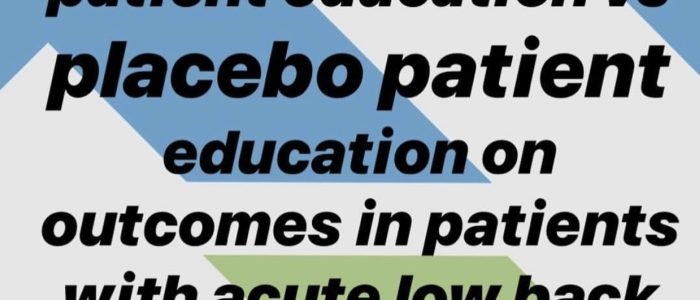Another article I came across via PT Inquest Podcast and I’m so glad I did! I think the pendulum has swung so far in the direction of “lets just talk the pain away!” that we’ve lost some perspective. This is such a great reminder that a majority of PTs are not trained in CBT and just educating patients is not enough. Dare I say it… maybe something is actually going on with their musculoskeletal system ? shocking.
Anyway, im totally biased and this is just one study (one study that included Lorimer Moseley as one of the patent educators…JS). What are your thoughts on this article or topic in general?? ⠀⠀⠀⠀⠀⠀⠀⠀⠀
Some key quotes from the article: ⠀⠀⠀⠀⠀⠀⠀⠀⠀
“To manage uncomplicated acute low back pain (fewer than 6 weeks of pain duration), international guidelines recom- mend that general practitioners provide advice, education, re- assurance, and simple analgesics, if necessary.6 Although many patients receiving this care improve rapidly, 33% experience a recurrence in the next 12 months7 and 20% to 30% develop chronic pain (defined as pain duration of 3 months or more)” ⠀⠀⠀⠀⠀⠀⠀⠀⠀
“The trial clinicians (A.C.T. and I.W.S.) who provided the patient education sessions were the same clinicians who provided the placebo patient education. An expert in pain education (G.L.M.) trained both trial clinicians to deliver the patient education intervention. An expert clinical psycholo- gist in pain management (M.K.N.) trained both trial clinicians in the placebo patient education intervention.” ⠀⠀⠀⠀⠀⠀⠀⠀⠀
“The patient education intervention in- volved 3 main components: (1) reframing unhelpful beliefs about low back pain, (2) presenting information about the bio- logic basis and protective nature of both acute and chronic low back pain, and (3) evaluating understanding of new concepts and discussing techniques to promote recovery.”.
⠀⠀⠀⠀⠀⠀⠀⠀⠀
“Our results suggest that offering more intensive patient educa- tion to patients with acute low back pain than that provided as part of standard practice does not reduce pain intensity or lead to meaningful reductions in disability.”


